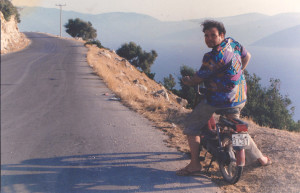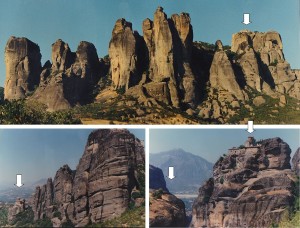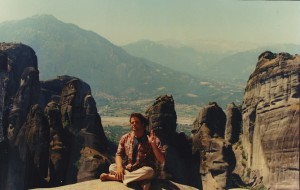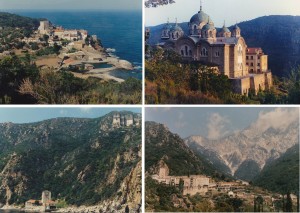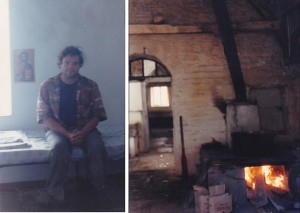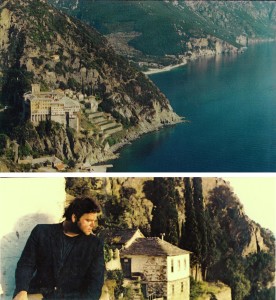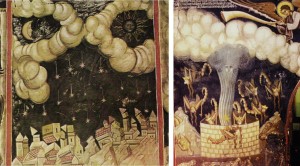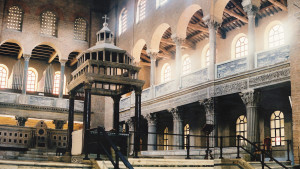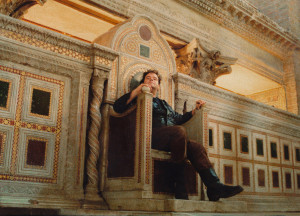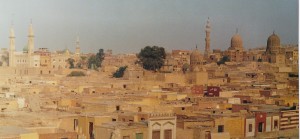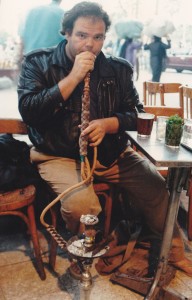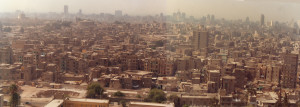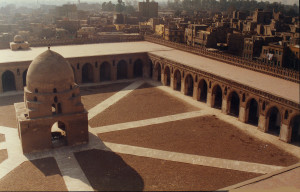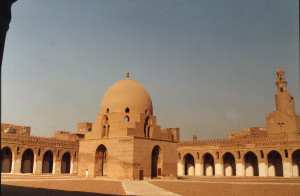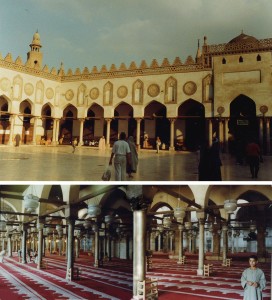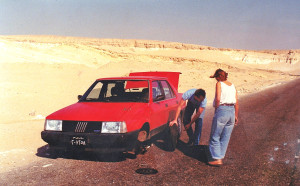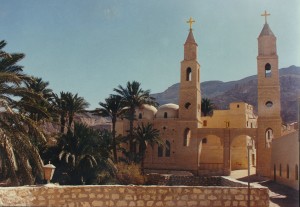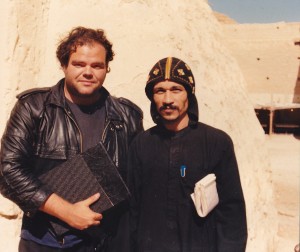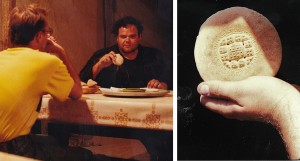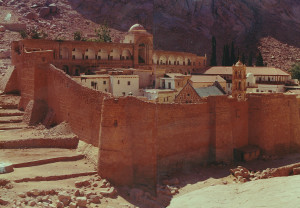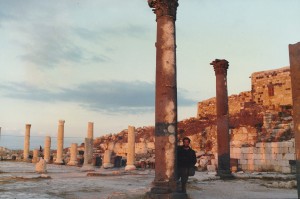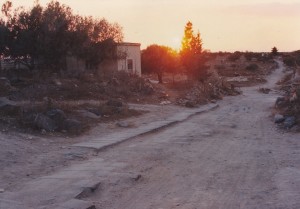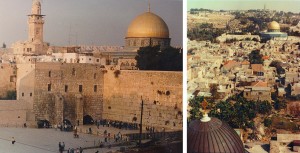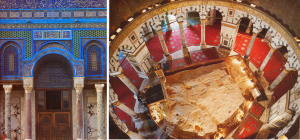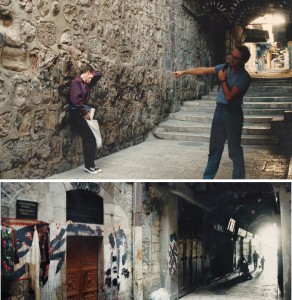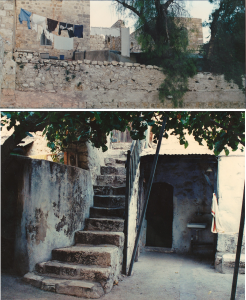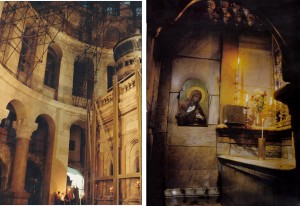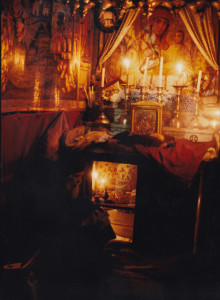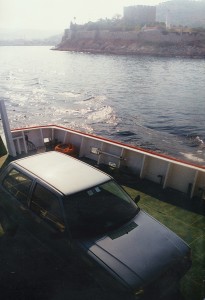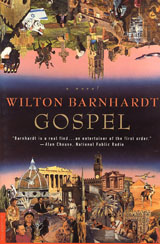The year was 1989 and I spent eight months traveling for the research on Gospel. Mind you, I really think with careful homework and a tiny bit of travel, one can make up everything necessary but if such travel can be written off as a business expense–I’ll be there! That’s me on my Vespa-like thing, speeding all over some Greek isle (I think Chios), hunting for monasteries. You’ll note the protective head and footwear.
England and America, Ireland, Africa, the Holy Lands, Italy and Greece… I followed Lucy and Dr. O’Hanrahan’s route pretty carefully with detours to places like Avignon, France, and Patmos, Greece, that ended up not making the book. I was 30 pages into the Patmos episode when that little voice–was it You, Holy Spirit?–intruded and whispered… Uh, it’s already too damn long–get them to Jerusalem already. Nor did the amazing monasteries of Meteora in Central Greece make the cut; I had at one time imagined a much-complaining O’Hanrahan climbing countless railing-less stairs en route to the summits… maybe being lowered in a basket down the side of a cliff to talk to a mystical monk in a cave (which is something that still exists), but nope.
But there was no escaping Mt. Athos, the holiest enclave of the Eastern Orthodox world: a mountainous, rugged peninsula of twenty monasteries founded in the 900s with little modernization since then, still 13 days behind on their Julian calendar, still keeping Byzantine time, where sundown is midnight. Little electricity, no phones, no modern plumbing, no conveniences beyond the central villages of Karyes–and no women. Only the Virgin Mary is allowed to place her foot on these shores; there are not even female animals. Consequently there are no herds and no grazing, and Athos is a vision of Greece untouched by agriculture… a paradise of lush verdure, dense forests, unpolluted waters.
Clockwise from the top left, Pantokrator, where I spent my first night. There was a ghost in the room; I was so exhausted from walking I didn’t care. The Prophet Elias skete was further up the mountain, a Russian sub-monastery, occupied by just seven monks… all with Brooklyn-accented English since they had learned their English from a Russian-American man from Brighton Beach, New York City. Before bedtime, I was counseled to pray for the restoration of the Czar to Russia; ikons of Nikolas and Alexandra, martyrs, were above my bed. The right lower monastery is St. Paul; the left lower is Simonos Petra.
A peek in the kitchen below. Hm, nothing but white navy beans in hot water, a spoonful of olive oil and a piece of old bread. No wonder they see visions on Athos, malnourished into delirium…
This was an infamous summer in Greece–120 degrees Fahrenheit, heat stroke in the cities, hundreds dying as a result. Yet on Athos, for monk and pilgrim alike, only one’s hands and face may be exposed when hiking up and down the mountains between monasteries (no skin to offend the Virgin… or perhaps to tempt the vulnerable monks with the dazzle of exposed flesh). The heat was too much and I did take a refreshing swim in the Aegean… but with my clothes on, since if I were discovered frolicking in the waters in my briefs by another monk on the trail, I would have been shipped off the peninsula at once.
Some of these photos suffer from the fact that my film camera (it’s 1989, remember) was getting cooked. Lots of disappointing pics amid the treasures, needless to say. The above monastery is Dionysiou (founded 1347), home of the Prophetic Frescoes of the Apocalypse…
The sun and moon are shrouded in eternal clouds (nuclear winter?) as the missiles rain down upon the cities and the people hide in caves; beyond the mushroom cloud, insects live on, wearing crowns, the cockroaches now the kings of the world… This was painted in the 1540s by the great Tzortis of Crete.
From the 1000s, the Roman Catholic and Orthodox worlds were at odds over a phrase in the Nicene Creed. If only they had turned to Antipope Wilton who would have excommunicated and anathematized everyone involved… Back in Rome, between trips to the Vatican Library, I went to the Seven Pilgrimage Churches to see what I could see, including San Lorenzo outside Rome’s walls, the martyrdom site where poor St. Lawrence was tossed on the grill. This under-touristed basilica was built mostly in the 500s and has so many odd chapels and crannies, that when it came to be lunch time, the sexton looked around, didn’t see anyone, and locked me inside… Pope Alexander IV had political difficulties and had to hide out here at San Lorenzo (which was way outside of Rome, once upon a time) and before retreating even further to Viterbo, he pontificated here. So I, Antipope Wilton I (I’m fairly sure I’m the first “Wilton”) set up the automatic timer and took my rightful place, ascending the Cosmati throne!
But then, Cairo. Twenty million people, largest metro in the Arab world, largest city of Africa, teeming under a baking sun, the air half-dust…
Searching out the Old City of Babylon (the Christian Cairo, with its near-subterranean Coptic churches), wandering the alleys and human traffic jams of the Fatimid city… Not sure how safe any of this would be now; my friends report things are a great deal more tense (even before the uprising), but back in 1989 we made our way unopposed to the grand, desolate ibn-Tulun Mosque (begun 876), amusing ourselves by climbing the ancient minaret.
…and even then, before writing the book, I knew Dr. O’Hanrahan would make his way to the second oldest university in the world, al-Azhar (from 975), to visit the greatest and most ancient library of Egypt.
The “we” were my friends Henrietta and James, buddies from Oxford, and later Christina. James Fergusson must have caught the Middle Eastern travel bug pretty bad because he has since gone to many more places to write about them, places you couldn’t drag me to, and I am fairly brave: Afghanistan (Taliban), Yemen, Somalia (The Most Dangerous Place in the World). These are fabulous books–I cannot recommend them enough, particularly my sentimental favorite, Kandahar Cockney, all of which should find print one day in America. But before being a distinguished British journalist with the ear of the prime minister, he was a monastery hunter with yours truly. He drove the manual beat-up car we rented while I held the stick-shift in place (!).
Christian monasticism began here in Egypt; tradition has it that Mary Magdalene founded the first convent here, and St. Anthony of the Desert had a monastery from the 200s… now THAT’S as old as anything Christian gets! We spent a few overnights in the monasteries because it took all day to get to them and bandits prowled the lonely roads at night. The guestmasters often spoke educated English; indeed, many of the Coptic monks were lawyers, doctors, professors–the most accomplished young men of Coptic society serve for a few years as a monk before rejoining the world.
Again, the less than luxe monastic cuisine… a nice plate of beans and oil (foul) and bread so mite-infested that we followed the lead of fellow pilgrims, banging it on the wood table until the bugs hopped out. This is unconsecrated host; the sixteen squares in the center correspond to certain areas of Christ’s body.
After St. Makarius (and its resident mystics and hermits), St. Bola, St. Anthony, and half a dozen discreetly marked Coptic churches–all commemorating a stop on the Holy Family’s journey during the Flight into Egypt–we finally made it to the Sacred and Imperial Monastery of the God-Trodden Mount of Sinai (from 540s), better known as St. Catherine’s after her relics were translated here. The most interesting thing inside was the note from the Prophet Mohammed guaranteeing the safety of the monks forever; he enjoyed their hospitality when passing through. Only the Vatican has more precious early church documents. I thought my characters would end up here, but their post-Jerusalem adventures didn’t allow for it…
Usually, I was “following” Lucy and Dr. O’Hanrahan in my mind, but sometimes, I wanted to go somewhere my disciple, the author of the book’s gospel, would have gone, which is to say, where Jesus Christ walked the earth. So, among other places, I investigated Um Qais in Jordan. I always thought the Flight into Egypt was a bit fishy, since an afternoon hike from the Sea of Galilee could have brought Joseph, Mary and child out of Herod’s jurisdiction, up to the hilltop town then known as Gedara.
Not much here anymore, but a good place to listen for traces of ancient times, to wonder how many disciples sat on which forum wall, having heard the sermon before. The place really never recovered from that rabbi guy 2000 years ago destroying the swine industry…
Jerusalem. The Old City is more or less just a square mile, but what an amazing piece of real estate, the focus of continual strife and conflict for millennia.
Like many pilgrims before us (and Lucy, O’Hanrahan and Rabbi Hersch in Gospel), we attempted the Stations of the Cross, finding the lithostrotos in the basement of one building (John 19:13), the Church of the Flagellation, the Church of the Condemnation, an Armenian chapel with a 5th Century mosaic floor and green tiles marking where Mary stood when she beheld her son (Our Lady of the Spasm). I’m not sure Christians can get to it as easily anymore, but nothing anywhere in the Holy Lands is as spectacular as Islam’s Dome of the Rock (691), the source for hundreds of Knights Templar chapels, not to mention Charlemagne’s home church at Aachen…
We noted that most pilgrims see the door the Holy Sepulcher and run for the big-ticket Stations (Disrobing, Crucifixion, Death, Deposition, Burial), but the back alleys of the Old City have small, hard to find markers of the oft-omitted Stations VII and VIII and IX. Christina and James and I tried to bring the eighth station to life–Jesus Speaks to the Daughters of Jerusalem, woe is you, etc. We went all over hunting for VII, but finally saw the little marker. Jesus Fell for the 2nd Time. I bet the mobs had broken up by the time he got to this small passageway; like the modern pilgrims, the locals had probably lost interest. I felt suddenly this must have been the loneliest part of Jesus’s ordeal.
After the equally obscure Station IX, you come out on the rooftop of the Chapel of St. Helena (part of the Sepulcher complex); here are the huts of the Ethiopian Orthodox. The Ethiopians have a traditional claim on the Sepulcher, but being poor and having few patrons, they’ve been chased off to the rooftop, and even there the Copts conspire to abrogate their privileges. O Holy Sepulcher, you old junkpile of tackiness (this means you, Franciscans!), ancientness, shabbiness, rottenness (the way the Christian sects go after each other) and confusion, a muddle of shadows and lost languages and tour bus pilgrims. Who is not disappointed the first time they see it? From the days of the Emperor Constantine, they chipped away at Golgotha and made a two story chapel out of it, then chipped away at the rock tombs, leaving a single slab, declaring it Jesus’s. Hard to imagine what the landscape looked like…
Beams hold up the old dome, girders reinforce the Aedicule (the mini-chapel around the slab) that Jesus’s body lay upon… the whole dump is falling apart. One evening, a half-hour before closing, we went in and NO ONE was inside. All the tours, all the pilgrims, the American evangelicals and the Portuguese widows in black on the bus tour of a lifetime, the nuns from West Africa, the French Catholic school fieldtrip… everybody was somewhere else. The only soul around was this Syrian Orthodox monk who guarded the sacred slab from a closet-sized outer room.
He spoke Aramaic–the very language of Jesus–and a little English. We figured we would never ever get a chance to have such unrushed quality time with where Jesus lay, so, agnostics all, we went in with our very best prayer wish-list, figuring this was the DIRECT LINE to the Christian Almighty, our only chance. “Are you here through the night?” we asked him, knowing they closed the Sepulcher to the public at seven p.m.. “Yes,” he said, “myself or another brother. Our Lord was alone on Calvary and in the tomb… but He will not be so again.”
The miraculous cave of the Libyan Desert, the miracle of the Angel sent with us by one of the Coptic monks as we made our way across deadly Saharan roads, the sickness from fake “bottled pure water” from Wadi Halfa, the lost passport in Cairo, the inability to get into Syria because of diplomatic squabbles back in London, the cancelled credit card before the Sudan, the hit-and-run sheep and the angry villagers pursuing us in Turkey, the rented car’s broken windshield due to Palestinian boys throwing rocks (it was Intifada One) when we went–admittedly, not too intelligently–to Hebron… too many stories to tell, and some so fantastic we’re not sure they even happened, although proof exists.
But God was surely with me because it was only on the ferry leaving Turkey for Rhodes, that Henrietta wondered aloud, “Did you pay for insurance for this rental car?” No, I shrugged. “And they let you take an Italian car to the Middle East?” A search of the glove compartment documents revealed it was not supposed to leave Italy. Ooops.
I returned it, much the worse for wear, in Milan. The attendant looked at the ridiculous mileage racked up, shook her head, made a face, mumbled something about someone putting down the original mileage wrongly, gave me my receipt and wished me a good day. It was You, wasn’t it, Holy Spirit? With me all the way!

